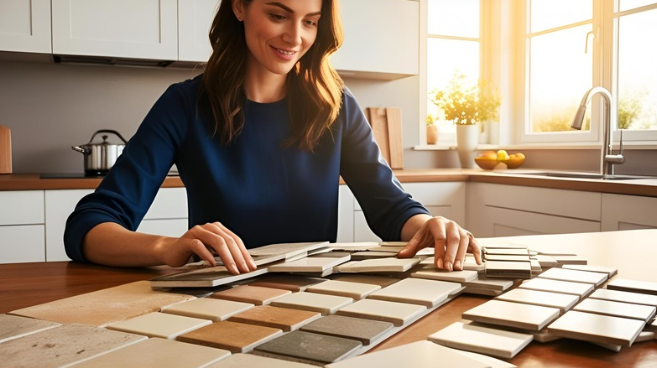When it comes to choosing tiles for your home or commercial space, one of the most common questions is, “Is porcelain the same as ceramic?” While porcelain and ceramic tiles share some similarities, they are not the same. Understanding the differences between these two materials is crucial for making an informed decision that suits your needs, budget, and design preferences. This article will explore the key differences between porcelain and ceramic tiles, their pros and cons, and help you decide which option is better for your specific application.
Understanding Porcelain and Ceramic Tiles
What is Ceramic Tile?
Ceramic tiles are made from a mixture of natural clay, sand, and water. The mixture is shaped, dried, and then fired in a kiln at high temperatures to create a hard, durable surface. Ceramic tiles are often coated with a glaze that adds color, pattern, and a protective layer. They are available in a wide variety of designs, making them a versatile choice for both residential and commercial spaces.
View Ceramics on Amazon
What is Porcelain Tile?
Porcelain tiles are a type of ceramic tile, but they are made from a more refined clay and fired at even higher temperatures. This process makes porcelain tiles denser, harder, and less porous than standard ceramic tiles. Porcelain tiles can be glazed or unglazed, and they are known for their durability, water resistance, and ability to mimic natural materials like stone and wood.
View Porcelain on Amazon
Key Differences Between Porcelain and Ceramic Tiles

To answer the question, “Is porcelain the same as ceramic?” let’s break down the key differences between the two materials.
1. Composition and Manufacturing Process
Ceramic Tiles: Ceramic tiles are made from a mixture of natural clay, sand, and water. The mixture is shaped, dried, and fired at temperatures between 1,800°F and 2,000°F. The tiles are often glazed to add color and a protective layer.
Porcelain Tiles: Porcelain tiles are made from a more refined clay and fired at higher temperatures, typically between 2,200°F and 2,500°F. This process makes porcelain tiles denser and less porous than ceramic tiles.
2. Durability and Strength
Ceramic Tiles: Ceramic tiles are durable but softer and more prone to chipping and cracking compared to porcelain tiles. They are better suited for low to moderate traffic areas, such as bathroom walls or decorative backsplashes.
Porcelain Tiles: Porcelain tiles are significantly harder and more durable than ceramic tiles. They are resistant to chipping, cracking, and wear, making them ideal for high-traffic areas like kitchens, hallways, and commercial spaces.
3. Water Resistance
Ceramic Tiles: Ceramic tiles are more porous than porcelain tiles, which means they absorb more water. While they can be used in wet areas, they require proper sealing to prevent water damage and staining.
Porcelain Tiles: Porcelain tiles have a very low water absorption rate (less than 0.5%), making them highly resistant to moisture. This makes them an excellent choice for wet areas like bathrooms, laundry rooms, and outdoor spaces.
4. Maintenance and Cleaning
Ceramic Tiles: Ceramic tiles require minimal maintenance but may need more frequent cleaning and sealing, especially in high-moisture areas.
Porcelain Tiles: Porcelain tiles are low-maintenance and easy to clean. Their non-porous surface resists stains, mold, and mildew, making them ideal for busy households.
5. Cost and Budget
Ceramic Tiles: Ceramic tiles are more budget-friendly, making them a popular choice for homeowners looking for an affordable yet stylish option.
Porcelain Tiles: Porcelain tiles are generally more expensive due to their superior durability and manufacturing process. However, their long lifespan and low maintenance requirements can make them a cost-effective choice in the long run.
6. Installation Process
Ceramic Tiles: Ceramic tiles are softer and easier to cut, making them a more DIY-friendly option. However, professional installation is still recommended for complex patterns or large areas.
Porcelain Tiles: Porcelain tiles are harder and denser, making them more challenging to cut and install. Professional installation is often recommended to ensure a proper fit and finish.
7. Design and Aesthetic Options
Ceramic Tiles: Ceramic tiles come in a variety of colors, patterns, and finishes. However, they may not offer the same level of detail and realism as porcelain tiles, especially when it comes to mimicking natural materials.
Porcelain Tiles: Porcelain tiles offer a wide range of design options, including realistic stone, wood, and marble looks. They are available in various colors, patterns, and finishes, allowing for greater design flexibility.
8. Weight and Structural Considerations
Ceramic Tiles: Ceramic tiles are lighter, making them easier to handle and install, especially in areas where weight is a concern.
Porcelain Tiles: Porcelain tiles are heavier than ceramic tiles due to their density. This can be a consideration when installing them on walls or upper floors, as additional structural support may be required.
9. Environmental Impact
Ceramic Tiles: Ceramic tiles are made from natural materials, but their shorter lifespan and higher maintenance requirements can make them less environmentally friendly compared to porcelain tiles.
Porcelain Tiles: Porcelain tiles are often considered more environmentally friendly due to their durability and long lifespan. They are made from natural materials and can be recycled, reducing their environmental footprint.
10. Slip Resistance
Ceramic Tiles: Ceramic tiles can be made with textured surfaces, but they may not offer the same level of slip resistance as porcelain tiles, especially when wet.
Porcelain Tiles: Porcelain tiles can be manufactured with textured surfaces that provide better slip resistance, making them a safer choice for wet areas like bathrooms and kitchens.
11. Thermal Conductivity
Ceramic Tiles: Ceramic tiles have good thermal conductivity, but they may not be as efficient as porcelain tiles when used with radiant floor heating systems.
Porcelain Tiles: Porcelain tiles have excellent thermal conductivity, making them a good choice for radiant floor heating systems. They can efficiently transfer heat, providing consistent warmth throughout the space.
Additional Considerations
12. Color Consistency
Ceramic Tiles: Ceramic tiles may have a colored glaze on the surface, which can wear away over time, revealing a different color underneath. This can make chips and scratches more noticeable.
Porcelain Tiles: Porcelain tiles often have consistent color throughout the body of the tile, which means that chips or scratches are less noticeable. This is particularly beneficial in high-traffic areas where wear and tear are more likely.
13. Application Versatility
Ceramic Tiles: Ceramic tiles are primarily used for indoor applications, such as flooring, walls, and backsplashes. While they can be used outdoors, they may not hold up as well as porcelain tiles in harsh weather conditions.
Porcelain Tiles: Due to their durability and water resistance, porcelain tiles are suitable for both indoor and outdoor applications. They can be used for flooring, walls, countertops, and even outdoor patios.
14. Longevity
Ceramic Tiles: While ceramic tiles are durable, they may not last as long as porcelain tiles, especially in high-traffic areas. However, with proper maintenance, they can still provide many years of service.
Porcelain Tiles: Porcelain tiles are known for their long lifespan, often lasting decades with proper care. This makes them a worthwhile investment for homeowners looking for a durable and long-lasting flooring solution.
15. Resale Value
Ceramic Tiles: Ceramic tiles can add value to your home, but they may not have the same impact as porcelain tiles. However, they are still a desirable feature, especially in kitchens and bathrooms.
Porcelain Tiles: Installing porcelain tiles can increase the resale value of your home due to their durability, low maintenance, and high-end appearance. Potential buyers often view porcelain tiles as a premium feature.
FAQs: Is Porcelain the Same as Ceramic?

1. Is porcelain the same as ceramic?
No, porcelain and ceramic tiles are not the same. While both are made from clay and fired in a kiln, porcelain tiles are made from a more refined clay and fired at higher temperatures, making them denser and more durable.
2. Which is more durable, porcelain or ceramic tile?
Porcelain tiles are more durable due to their higher density and resistance to wear and tear. They are ideal for high-traffic areas and can withstand heavy use without chipping or cracking.
3. Are porcelain tiles more expensive than ceramic tiles?
Yes, porcelain tiles are typically more expensive, but their long lifespan and low maintenance make them a cost-effective choice in the long run.
4. Can ceramic tiles be used in wet areas?
Ceramic tiles can be used in wet areas with proper sealing, but porcelain tiles are a better choice due to their low porosity.
5. Which tile is easier to install, porcelain or ceramic?
Ceramic tiles are easier to install due to their softer composition, but professional installation is recommended for both types.
6. Do porcelain tiles require less maintenance than ceramic tiles?
Yes, porcelain tiles require less maintenance due to their non-porous surface and resistance to stains.
7. Can porcelain tiles mimic natural materials like stone and wood?
Yes, porcelain tiles can closely mimic natural materials, offering a wide range of design options.
8. Are porcelain tiles heavier than ceramic tiles?
Yes, porcelain tiles are heavier, which may require additional structural support during installation.
9. Which tile is more environmentally friendly, porcelain or ceramic?
Porcelain tiles are often considered more environmentally friendly due to their durability and recyclability.
10. Are porcelain tiles more slip-resistant than ceramic tiles?
Porcelain tiles can be manufactured with textured surfaces for better slip resistance, making them safer for wet areas.
Conclusion: Is Porcelain the Same as Ceramic?
The answer to “Is porcelain the same as ceramic?” is a resounding no. While both materials share some similarities, they have distinct differences in terms of composition, durability, water resistance, maintenance, cost, and design options. Porcelain tiles are denser, more durable, and better suited for high-traffic and wet areas, making them a premium choice for many homeowners. On the other hand, ceramic tiles are more affordable, easier to install, and offer a wide range of design options, making them a popular choice for budget-conscious projects.
Ultimately, the choice between porcelain and ceramic tiles depends on your specific needs, budget, and design preferences. By understanding the key differences between these two materials, you can make an informed decision that enhances the beauty and functionality of your space. Whether you choose porcelain or ceramic, both options offer unique advantages that can transform your home or commercial space into a stylish and durable environment.
Read more articles
1 How to Use a Ceramic Incense Burner: A Complete Guide